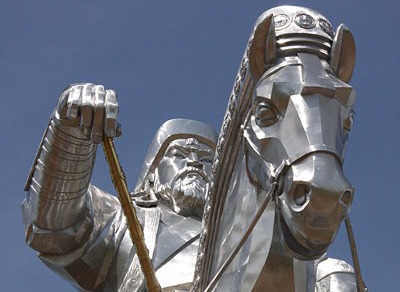 For one thing, this statue has large carbon footprints.Photo: ChinneebInfamous Mongol warlord Genghis Khan conquered much of Central Asia and China and killed tens of millions of people along the way. But in a clear case of researchers taking the lemons of history and trying to make some delicious, 800-year-old lemonade, a recent study highlights the supposed green benefits of Genghis’ mass slaughter:
For one thing, this statue has large carbon footprints.Photo: ChinneebInfamous Mongol warlord Genghis Khan conquered much of Central Asia and China and killed tens of millions of people along the way. But in a clear case of researchers taking the lemons of history and trying to make some delicious, 800-year-old lemonade, a recent study highlights the supposed green benefits of Genghis’ mass slaughter:
[Genghis’ impact on climate] can be told in one word: reforestation. When the Mongol hordes invaded Asia, the Middle East, and Europe they left behind a massive body count, depopulating many regions. With less people, large swathes of cultivated fields eventually returned to forests, absorbing carbon dioxide from the atmosphere.
In fairness to the researchers, they were merely trying to explore various instances of human-caused climate change in history. The “history’s greenest conqueror” angle is courtesy of Mother Nature Network.
“The reality may be a bit difficult for today’s environmentalists to stomach,” writes MNN’s Bryan Nelson. You don’t say.
Check the MetaFilter comment thread for appropriate snarky reaction; highlights include “Pol Pot wasn’t repressing his people — he was going green” and “Jonathan Swift: Ireland’s most modest gourmand?”
But this notion that Genghis was green in any way is really off base. If there was anything he liked more than slaughtering entire cities, it was fathering children. As Ian Frazier writes in his book Travels in Siberia:
Genghis had hundreds of wives and concubines among different harems around his empire. … Of course, Genghis and his heirs fathered many children. A Persian historian writing about the Mongols in 1260 [Ed.: Genghis died in 1227] said that by then the Mongol leader had twenty thousand descendants living; the historian added that he knew he would be accused of exaggerating.
Recently, geneticists from Oxford University working with colleagues from China, Pakistan, Mongolia, and Uzbekistan spent 10 years taking blood samples from men in Central Asia to study the Y chromosome, which is passed from father to son. The geneticists found that a distinctive cluster of Y chromosomes in the DNA of 8 percent of the men indicated descent from a single common ancestor about a thousand years ago. The geneticists believed that the ancestor was Genghis Khan (or rather, an eleventh-century ancestor of Genghis Khan). From this study they concluded that in Central Asia, about sixteen million men — or about one-half of one percent of the world’s entire male population — is descended from Genghis Khan.
GINK he wasn’t.



